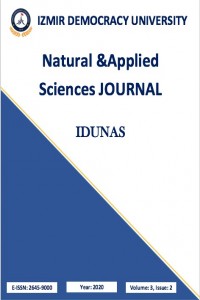Abstract
References
- REFERENCES
- 1. Baysoy, E., Yildirim, D., Ozsoy, C., Mutlu, S., Kocaturk, O. (2016). Thin fillm based semi-active resonant marker design for low profile interventional cardiovascular MRI devices. Magnetic Resonance Materials in Physics, Biology and Medicine, 30(1), 93-101. Doi:10.1007/s10334-016-0586-8).
- 2. Lederman, R.J. (2006). NIH Public Access, 112(19), 3009-3017.
- 3. Barkhausen, J., Kahn, T., Krombach, G.A., Kuhl, C.K., Lotz, J., Maintz, D., Ricke, J., Schönberg, S.O., Vogl, T.J. and Wacker, F.K. (2017). White Paper: Interventional MRI: Current Status and Potential for Development Considering Economic Perspectives, Part 1: General Application. RoFo: Fortschritte auf dem Gebiete der Rontgenstrahlen und der Nuklearmedizin, 189(7), 611-623. Doi:10.1055/s-0043-110011.
- 4. Gurler, N. & Ider, Y.Z. (2015). Numerical methods and software tools for simulation, design, and resonant mode analysis of radio frequency birdcage coils used in MRI. Concepts Magn. Reson., 45, 13-32. Doi:10.1002/cmr.b.21279.
- 5. Tadesse, Y. (2015). The electromagnetic simulation of birdcage coils for MRI based on Finite element method. Master of degree thesis, Youngstown State University, Ohio, The United States of America.
- 6. Sonmez, M., Saikus, C.E., Bell, J.A., Franson, D.N., Halabi, M., Faranesh, A.Z., Ozturk, C., Lederman, R.J., Kocaturk, O. (2012). MRI active guidewire with an embedded temperature probe and providing a distinct tip signal to enhance clinical safety. Journal of Cardiovascular Magnetic Resonance, 14, 38. Doi:10.1186/1532-429X-14-38.
Abstract
RF MARKER SIMULATION MODEL FOR INTERVENTIONAL MRI APPLICATIONS
Compared to the other imaging modalities Magnetic Resonance Imaging (MRI) system has many advantages. There is a great demand to carry out interventional cardiovascular procedures under MRI scanner. However, the lack of visible markers and MRI compatible interventional instruments and devices, is the main problem for realizing clinical applications with MRI guidance. In order to provide widespread usage of MRI for endovascular operations, commercial catheters and guidewires must be manufactured by considering many performance criteria including visualization, miniaturization, flexibility and safety.
In this study, an orientation independent simulation model was developed and validated to obtain a reliable method for evaluating the designed RF marker structures in a MRI environment. Utilized RF coil designs have similar size and properties with former constructed clinical grade MRI compatible RF markers in experimental works [1]. Finite Element Method (FEM) simulations were carried out for different RF coil designs to make the computational analysis of their electrical and magnetic characteristics by using COMSOL Multiphysics program.
By delineating an approved simulation platform of a MRI environment, various different designs of RF marker prototypes can be compared between each other in many aspects, instead of realizing these models. Proposed simulation platform enables a convenient facility to determine various parameters of micro coils that have significant effects on visibility and safety performance of the candidate designs including signal to noise ratio (SNR) and Quality (Q) factor, RF induced heating and specific absorption rate (SAR).
Keywords
References
- REFERENCES
- 1. Baysoy, E., Yildirim, D., Ozsoy, C., Mutlu, S., Kocaturk, O. (2016). Thin fillm based semi-active resonant marker design for low profile interventional cardiovascular MRI devices. Magnetic Resonance Materials in Physics, Biology and Medicine, 30(1), 93-101. Doi:10.1007/s10334-016-0586-8).
- 2. Lederman, R.J. (2006). NIH Public Access, 112(19), 3009-3017.
- 3. Barkhausen, J., Kahn, T., Krombach, G.A., Kuhl, C.K., Lotz, J., Maintz, D., Ricke, J., Schönberg, S.O., Vogl, T.J. and Wacker, F.K. (2017). White Paper: Interventional MRI: Current Status and Potential for Development Considering Economic Perspectives, Part 1: General Application. RoFo: Fortschritte auf dem Gebiete der Rontgenstrahlen und der Nuklearmedizin, 189(7), 611-623. Doi:10.1055/s-0043-110011.
- 4. Gurler, N. & Ider, Y.Z. (2015). Numerical methods and software tools for simulation, design, and resonant mode analysis of radio frequency birdcage coils used in MRI. Concepts Magn. Reson., 45, 13-32. Doi:10.1002/cmr.b.21279.
- 5. Tadesse, Y. (2015). The electromagnetic simulation of birdcage coils for MRI based on Finite element method. Master of degree thesis, Youngstown State University, Ohio, The United States of America.
- 6. Sonmez, M., Saikus, C.E., Bell, J.A., Franson, D.N., Halabi, M., Faranesh, A.Z., Ozturk, C., Lederman, R.J., Kocaturk, O. (2012). MRI active guidewire with an embedded temperature probe and providing a distinct tip signal to enhance clinical safety. Journal of Cardiovascular Magnetic Resonance, 14, 38. Doi:10.1186/1532-429X-14-38.
Details
| Primary Language | English |
|---|---|
| Journal Section | Articles |
| Authors | |
| Publication Date | December 25, 2020 |
| Acceptance Date | July 8, 2020 |
| Published in Issue | Year 2020 Volume: 3 Issue: 2 |


